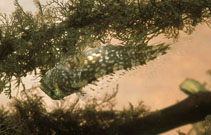| Family: |
Blenniidae (Combtooth blennies), subfamily: Salariinae |
| Max. size: |
5.07 cm SL (male/unsexed) |
| Environment: |
demersal; freshwater; brackish |
| Distribution: |
South America: Brazil. Due to the steady decline of streams and mangroves along the Brazilian coast, lower risk (LR nt) status in the IUCN Red List is proposed. |
| Diagnosis: |
|
| Biology: |
Adults prefer the tunnels drilled by ship-worms in submersed branches of bank vegetation. At ebb tide, may seek vacant hollows and endure hours out of the water. They feed on isopod and amphipod crustaceans. Occasionally, they swim like a half-waterlogged leaf moving in the slow current. Oviparous (Ref. 205). Eggs are demersal and adhesive (Ref. 205). Egg clutches found within drilled tunnels by ship-worms are attended by the male (Ref. 49399). Sexually dimorphic males with higher dorsal fin and prominent flap on its anterior edge. Territorial males adopt a dark color while flashing the bright turquoise spot on dorsal fin. Contests are size-dominated and may be restricted to displaying dark colors and turquoise spot, or the opponents may enter in physical combat, nipping at each other. Larvae hatch at about 3.5 mm and settle at about 8 mm SL (Ref. 49399). |
| IUCN Red List Status: |
Endangered (EN); Date assessed: 25 March 2011 (B2ab(iii)) Ref. (130435)
|
| Threat to humans: |
harmless |
Source and more info: www.fishbase.org. For personal, classroom, and other internal use only. Not for publication.

